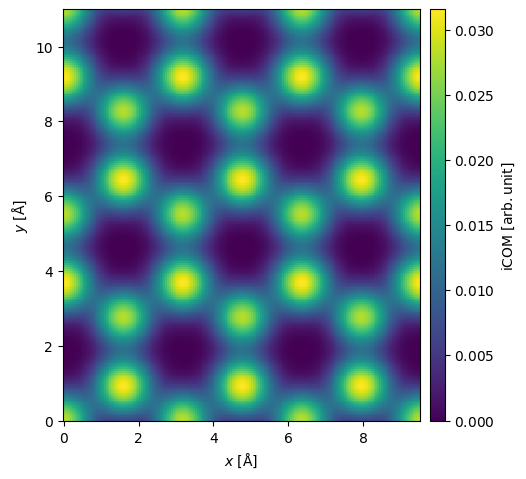Scan and detect#
Scanning imaging modes such as STEM work by rastering a focused electron probe across the sample pixel by pixel, and recording the scattering signal for each position. To simulate this we have to perform a multislice simulation for every probe position.
Scanned multislice#
We start by creating a model of MoS2, whose unit cell we repeat to accomodate the size of the probe wave function (see our multislice walkthrough).
atoms = ase.build.mx2(vacuum=2)
atoms = abtem.orthogonalize_cell(atoms)
atoms = atoms * (5, 3, 1)
fig, (ax1, ax2) = plt.subplots(1, 2, figsize=(12, 4))
abtem.show_atoms(atoms, title="Beam view", ax=ax1)
abtem.show_atoms(atoms, legend=True, plane="xz", title="Side view", ax=ax2);

Next, we create a Potential with a sampling of \(0.05 \ \mathrm{Å}\) and a Probe with an energy of \(80 \ \mathrm{keV}\) and a convergence semiangle of \(20 \ \mathrm{mrad}\) (and match its sampling to the potential).
potential = abtem.Potential(atoms, sampling=0.05)
probe = abtem.Probe(energy=80e3, semiangle_cutoff=20)
probe.grid.match(potential)
abTEM implements three scan types:
GridScan: Uniformly spaced axis-aligned 2D grid of probe positions.LineScan: Uniformly spaced probe positions along a line with an arbitrary direction.CustomScan: Defines the probe positions as an arbitrary \(N \times 2\) array of numbers.
The GridScan is most commonly used, however, the LineScan may be a way to save computations.
Below we create a LineScan by giving the start and end point as a fraction of the potential.extent. We specify 50 grid points along the scan. We set endpoint=False, because the scan covers a periodic region and thus the specified start and end is equivalent. Setting endpoint=False when scanning over a periodic unit will allow us to tile the resulting measurement.
The scan types may be overlaid (red line) on top of a visualization of the atoms using add_to_axes.
line_scan = abtem.LineScan(
start=(potential.extent[0] / 5.0, 0.0),
end=(potential.extent[0] / 5.0, potential.extent[1] / 3.0),
gpts=50,
endpoint=False,
)
fig, ax = abtem.show_atoms(atoms)
line_scan.add_to_axes(ax, color="r")

Calling multislice with the LineScan and Potential will result in the exit wave functions for every probe position along the scan, i.e. an ensemble of \(50\) wave functions.
exit_waves_line = probe.multislice(potential=potential, scan=line_scan)
Applying detectors#
In experiments, the exit wave functions are measured using detectors, and correspondingly abTEM implements several detector types. For now, we shall focus on the AnnularDetector, which, depending on the choice of integration region, can represent the detector used in bright-field, medium- or high-angle annular dark-field microscopy, abbreviated BF, MAADF and HAADF, respectively.
Below we create a detector for BF, MAADF and HAADF by specifying the inner and outer radial integration angle in \(\mathrm{mrad}\).
bright = abtem.AnnularDetector(inner=0, outer=30)
maadf = abtem.AnnularDetector(inner=50, outer=120)
haadf = abtem.AnnularDetector(inner=90, outer=200)
print(
f"Maximum simulated scattering angle = {min(exit_waves_line.cutoff_angles):.1f} mrad"
)
Maximum simulated scattering angle = 278.0 mrad
We note that the maximum simulated angle (\(278 \ \mathrm{mrad}\)) is greater than the maximum detected angle (\(200 \ \mathrm{mrad}\)). An error will be thrown, if this is not true, in which case you need to increase the real-space sampling of the Probe.
The detector regions, given a wave function, may be retrieved using the get detector region. We stack the detector regions and show them.
bright_region = bright.get_detector_region(exit_waves_line)
maadf_region = maadf.get_detector_region(exit_waves_line)
haadf_region = haadf.get_detector_region(exit_waves_line)
stacked_regions = abtem.stack(
(bright_region, maadf_region, haadf_region), ("bright", "MAADF", "HAADF")
)
visualization = stacked_regions.show(
explode=True, cbar=True, common_color_scale=True, units="mrad", figsize=(12, 4)
)

The detectors can be applied by using the .detect method. Since we used a LineScan, the exit wave functions are converted to RealSpaceLineProfiles.
haadf.detect(exit_waves_line)
<abtem.measurements.RealSpaceLineProfiles at 0x1c12338c0>
Scanning and detecting may be combined when using scan with a list of detectors producing a list of LineProfiles with an entry corresponding to each detector.
all_detectors = [bright, maadf, haadf]
measurements = probe.scan(
potential, detectors=all_detectors, scan=line_scan
).compute();
We show the RealSpaceLineProfiles below.
measurements = abtem.stack(measurements, ("Bright field", "MAADF", "HAADF"))
visualization = measurements.show(explode=True, common_scale=False, figsize=(12, 3))

The probe is normalized to integrate to \(1\) in reciprocal space. Looking at the plot showing the bright field intensity, we can conclude that there is almost no scattering in the hexagon centers (i.e. for \(r\sim 2\) \(\mathrm{Å}\)), while \(\sim5 \%\) of the electrons scatter outside the bright-field disk when the probe is placed directly on the Mo atoms (i.e. for \(r = 0\)).
STEM simulations#
We perform typical STEM simulations using a GridScan much the same as we did with the LineScan above. We define a scan across a periodic unit of the potential using fractional coordinates by setting fractional=True, thus the arguments for stafrt and end will be .
The probe step size (or sampling) is set to the Nyquist frequency of the probe contrast transfer function.
sampling = probe.aperture.nyquist_sampling
print(f"Nyquist sampling = {sampling:.3f} Å/pixel")
Nyquist sampling = 0.522 Å/pixel
grid_scan = abtem.GridScan(
start=[0, 0],
end=[1 / 5, 1 / 3],
sampling=sampling,
fractional=True,
potential=potential,
)
fig, ax = abtem.show_atoms(atoms)
grid_scan.add_to_plot(ax)
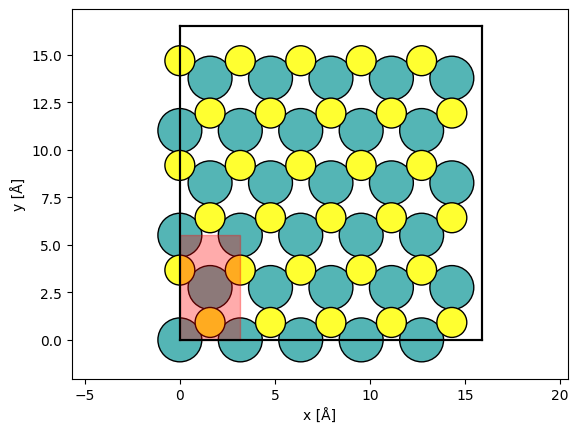
We set up the STEM simulation, which will result in a list of Images.
measurements = probe.scan(potential, scan=grid_scan, detectors=all_detectors)
It is convenient to stack the measurements into a single Images object, so that they can be saved as a single file.
measurements = abtem.stack(measurements, ("BF", "MAADF", "HAADF"))
We write the Images to disk, which will trigger the computations to run (this will take around 20 s).
measurements.to_zarr("mos2_stem_measurements.zarr");
We show the resulting Images below.
imported_measurements = abtem.from_zarr("mos2_stem_measurements.zarr").compute()
imported_measurements.show(explode=True, cbar=True, figsize=(10, 5));

Post-processing STEM measurements#
STEM simulations usually requires some post-processing, and we apply the most common steps below.
Interpolation#
We saved a lot of computational time by scanning at the Nyquist frequency, but the result is quite pixelated. To address this, we interpolate the images to a sampling of \(0.1 \ \mathrm{Å / pixel}\). abTEM’s default interpolation algorithm is Fourier-space padding, but spline interpolation is also available, which is more appropriate if the image in non-periodic.
interpolated_measurement = imported_measurements.interpolate(sampling=0.1)
visualization = interpolated_measurement.show(explode=True, cbar=True, figsize=(10, 5))
visualization.axes.set_sizes(cbar_spacing=1)
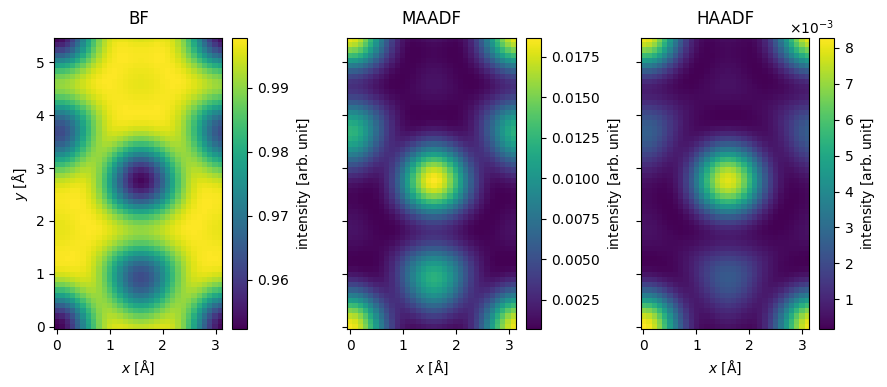
Blurring#
A finite Gaussian-shaped source will result in a blurring of the image. Vibrations and other instabilities may further contribute to the blur. We apply a Gaussian blur with a standard deviation of \(0.5 \ \mathrm{Å}\) (corresponding to a source of approximately that size).
See also
We are not including partial temporal incoherence here. See our tutorial on partial coherence in STEM simulations for a detailed description, as well as a more rigorous treatment of partial spatial coherence using the contrast transfer function.
blurred_measurement = interpolated_measurement.gaussian_filter(0.5)
blurred_measurement.show(explode=True, figsize=(12, 4));

Noise#
Simulations such as the above corresponds to the limit of an infinite electron dose. An image with a finite electron dose will contain shot noise. We can get a random sample for a finite dose by drawing random numbers from a Poisson distribution for every pixel. The Poisson distribution has a mean of
where it is assumed that intensity of the reciprocal space probe is normalized to integrate to \(1\).
Before applying the noise, we tile the images to get better statistics.
tiled_measurement = blurred_measurement.tile((7, 4))
We apply Poisson noise corresponding a dose per area of \(10^5 \ \mathrm{e}^- / \mathrm{Å}^2\).
noisy_measurement = tiled_measurement.poisson_noise(dose_per_area=1e5, seed=100)
While most of the electrons are collected in BF, we get the best signal in MAADF and HAADF provides the best Z-contrast.
noisy_measurement.show(explode=True, figsize=(12, 4));
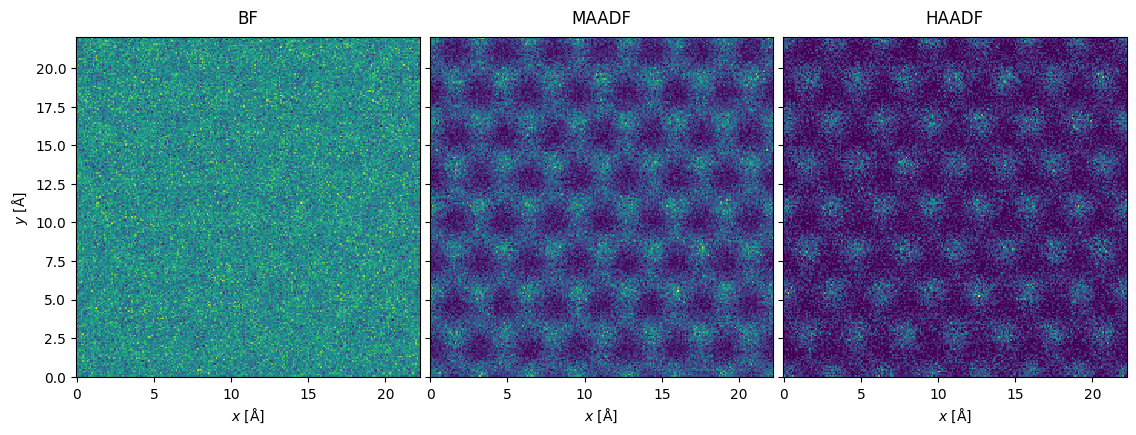
Poisson noise is generally the most important source of noise in STEM images, but scan noise due to vibrations and voltage instabilities in the scan coils may also be significant[JN13], see abtem.measure.apply_scan_noise. For completeness, we note that thermal noise in the detector material may also contribute.
Detectors#
Many kinds of detectors are widely used in STEM, and abTEM accordingly implements the following detector types:
AnnularDetector: Integrates diffraction patterns between two scattering angles. Used for BF, MAADF and HAADF.FlexibleAnnularDetector: Bins diffraction patterns in radial regions. Used for BF, MAADF and HAADF, allowing the angles to be adapted after the simulation.SegmentedDetector: Bins diffraction patterns in radial and azimuthal regions. Used for differential phase constrast STEM (DPC-STEM).PixelatedDetector: Detects full diffraction patterns. Used for 4D-STEM.WavesDetector: Detects the full wave function. Mostly for internal use.
The AnnularDetector was introduced in the preceding section, and in the following the rest of the detectors are discussed.
FlexibleAnnularDetector#
The FlexibleAnnularDetector radially bins the diffraction pattern, thus allowing us to choose the integration limits after running the simulation. Compared to saving the full diffraction pattern, the advantage of this detector is its significantly reduced memory or disk usage. The FlexibleAnnularDetector is the default detector for STEM simulations in abTEM.
Here, we create a detector with a spacing between detector bins of \(1 \ \mathrm{mrad}\).
flexible_detector = abtem.FlexibleAnnularDetector(step_size=1)
We run the scanned multislice simulations.
flexible_measurement = probe.scan(
potential, scan=grid_scan, detectors=flexible_detector
)
We can compute before choosing the integration limits
flexible_measurement.compute()
<abtem.measurements.PolarMeasurements at 0x1c1373ed0>
The result is PolarMeasurements; the measurement values are binned on a uniform polar grid, where two base axes represents the radial and azimuthal directions, respectively. In this case, there is only a single azimuthal coordinate.
We can reproduce the BF, MAADF and HAADF measurements obtained from the AnnularDetector above by integrating the PolarMeasurements.
stacked = abtem.stack(
[
flexible_measurement.integrate_radial(0, 30),
flexible_measurement.integrate_radial(50, 120),
flexible_measurement.integrate_radial(90, 200),
],
("BF", "MAADF", "HAADF"),
)
stacked.show(explode=True, cbar=True, figsize=(10, 5));
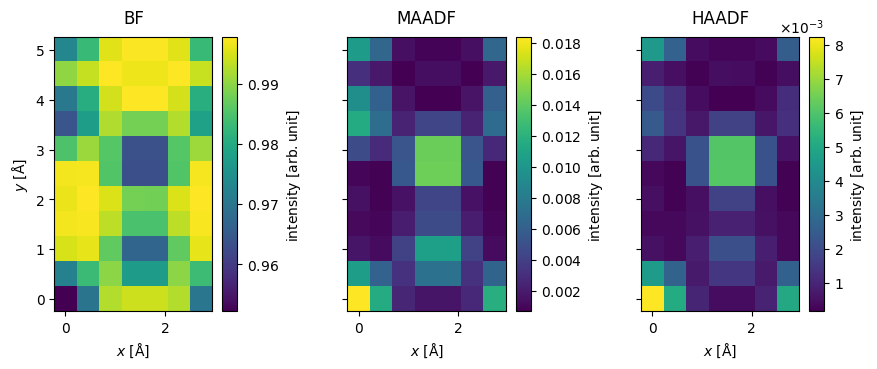
SegmentedDetector#
The SegmentedDetector covers an annular region and is partitioned into several detector regions forming radial and azimuthal segments.
Below we define a SegmentedDetector covering the annular region between \(40\) and \(80 \ \mathrm{mrad}\). It is divided
into \(2\) radial regions, each of which are divided into \(4\) azimuthal regions. The detector regions are rotated by \(45 \ \mathrm{deg.}\) with respect to the cartesian axes.
segmented_detector = abtem.SegmentedDetector(
inner=40, outer=80, nbins_radial=2, nbins_azimuthal=4, rotation=np.pi / 4
)
We may illustrate the detector regions below.
segmented_detector.show(probe, cbar=True);

We then run the scanned multislice simulation.
segmented_measurement = probe.scan(
potential, scan=grid_scan, detectors=segmented_detector
)
The resulting PolarMeasurement is 4D, the first two (ensemble) axes representing the scan directions and the last two (base) axes represents the radial and azimuthal bin axes.
segmented_measurement.shape
(7, 11, 2, 4)
segmented_measurement.axes_metadata
type label coordinates
---------- -------------------------------- ------------------
ScanAxis x [Å] 0.00 0.45 ... 2.73
ScanAxis y [Å] 0.00 0.50 ... 5.01
LinearAxis Radial scattering angle [mrad] 40.00 60.00
LinearAxis Azimuthal scattering angle [rad] 0.79 2.36 ... 5.50
segmented_measurement.compute();
We show the detected intensities for scan positions along \(x\) at \(y=0.5 \ \mathrm{Å}\) on a polar plot. We see that the electrons attracted toward the positions of the Mo atoms.
segmented_measurement[::2, 1].show(
cbar=True, explode=True, common_color_scale=True, units="mrad", title=True, figsize=(12,4)
);

Below we calculate the differential signals in the \(x\)- and \(y\)-directions. The differential signal in the \(x\)-direction is calculated as the difference between detector regions 3 and 1, for the \(y\)-direction it is the difference between detector regions 0 and 2.
differential = segmented_measurement.differentials(
direction_1=[(1,), (3,)],
direction_2=[(2,), (0,)],
return_complex=True,
)
The differential signal is returned as complex Images, where the real and imaginary parts correspond to the \(x\)- and \(y\)-direction, respectively.
To show the results, we first interpolate and tile. The different representations of the complex parts are stacked to show them as an exploded plot.
interpolated_differential = (
differential.interpolate(0.05).gaussian_filter(0.3).tile((3, 2))
)
abtem.stack(
[
interpolated_differential.real(),
interpolated_differential.imag(),
interpolated_differential.abs(),
interpolated_differential.phase(),
],
("real", "imaginary", "abs", "phase"),
).show(explode=True, figsize=(12, 4));

We can also display the complex Images using domain coloring.
interpolated_differential.show(cbar=True);
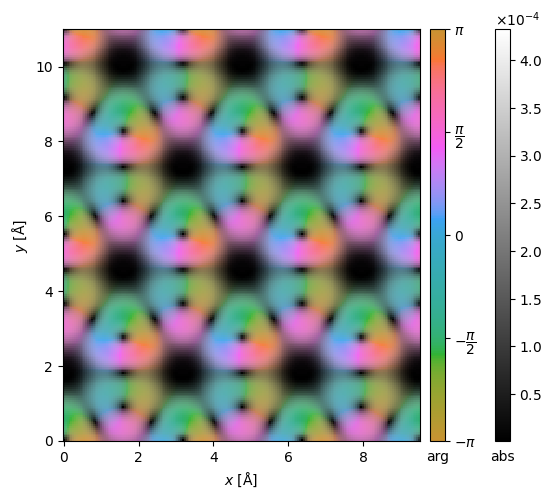
Integrated DPC (iDPC) is further a popular phase-contrast imaging technique, which can be easily simulated by integrating gradients over the detector segments.
idpc = interpolated_differential.integrate_gradient()
visualization = idpc.show()
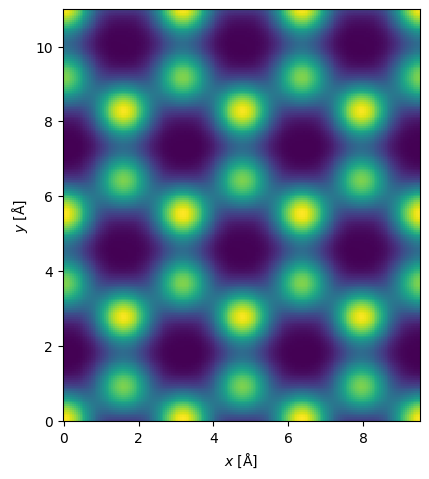
PixelatedDetector#
The PixelatedDetector records the diffraction patterns for every probe position. Hence, a 2D scan with this detector results in a four-dimensional dataset. The 4D datasets can be used to reconstruct the results of all the other detector geometries.
Below we create a PixelatedDetector saving the diffraction patterns up to \(200 \ \mathrm{mrad}\) and run the scanned multislice algorithm.
pixelated_detector = abtem.PixelatedDetector(max_angle=200)
pixelated_measurements = probe.scan(
potential,
scan=grid_scan,
detectors=pixelated_detector,
)
pixelated_measurements.compute();
We can get the sampling in \(1/\mathrm{Å}\) or \(\mathrm{mrad}\) as below.
pixelated_measurements.sampling, pixelated_measurements.angular_sampling
((0.06289308176100629, 0.060518896141470206),
(2.6262365135153236, 2.527097263389494))
In general the sampling in \(x\) and \(y\) will be different, we can optionally resample the diffraction patterns to be uniform or some specified sampling using the interpolate method.
pixelated_measurements.interpolate("uniform").sampling
(0.06289308176100629, 0.06289308176100629)
We show the detected intensities for scan position (1, 1) up to \(80 \ \mathrm{mrad}\). Since the diffraction pattern is often dominated by the direct disk, it is sometimes preferable to block the direct intensity.
We can make the same observation, as we did for the SegmentedDetector: the electrons are attracted in the direction of the atomic potential.
cropped_diffraction_pattern = pixelated_measurements[1, 1].crop(max_angle=80)
abtem.stack(
[
cropped_diffraction_pattern,
cropped_diffraction_pattern.block_direct(),
],
("base", "block direct"),
).show(explode=True, cbar=True, figsize=(13, 4));

As an alternative to blocking the direct disk, we can show the diffraction pattern on a power scale to relatively enhance the low intensities.
cropped_diffraction_pattern.show(power=0.2, cbar=True);
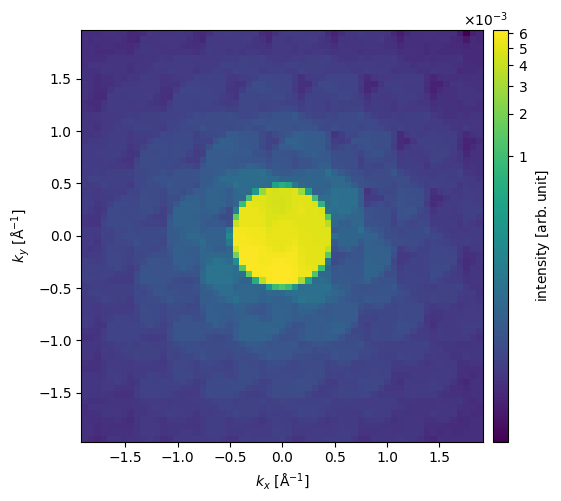
We can obtain the annular integrated measurements from the diffraction patterns by integrating radially as shown below.
stacked = abtem.stack(
[
pixelated_measurements.integrate_radial(0, 30),
pixelated_measurements.integrate_radial(50, 120),
pixelated_measurements.integrate_radial(90, 200),
],
("BF", "MAADF", "HAADF"),
)
stacked.show(explode=True, cbar=True, figsize=(13, 5));
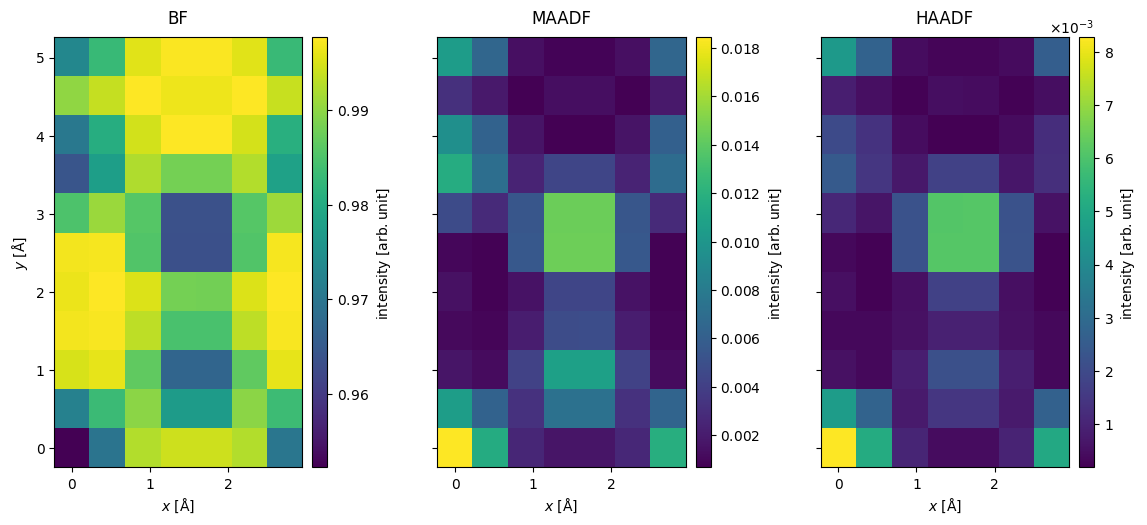
The center of mass, \(\vec{I}_{com}(\vec{r}_p)\), of the diffraction pattern at a probe position, \(\vec{r}_p\), may be calculated as
where \(\hat{I}(\vec{k})\) is a diffraction pattern intensity. Doing this for every diffraction pattern, we obtain the image shown below. The center of mass is returned as complex Images, where the real and imaginary parts correspond to the \(x\)- and \(y\)-direction, respectively. We set units="reciprocal", hence each complex component is in units of \(\mathrm{Å}^{-1}\).
center_of_mass = pixelated_measurements.center_of_mass(units="1/Å")
interpolated_center_of_mass = center_of_mass.interpolate(0.05).tile((3, 2))
interpolated_center_of_mass.show(cbar=True);

It may be shown[LBL16], in the weak-phase approximation, that by integrating \(\vec{I}_{com}(\vec{r}_p)\), we can obtain the phase change of the exit wave, \(\phi(\vec{r_p})\), cross-correlated with the probe intensity
This is the so-called integrated center of mass. We can calculate this using the integrate_gradient method, which assumes a complex Image.
integrated_gradient = center_of_mass.integrate_gradient()
interpolated_integrated_gradient = integrated_gradient.interpolate(0.05).tile((3, 2))
interpolated_integrated_gradient.show(cbar=True);
